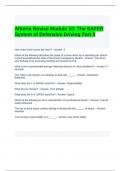Alberta novice module 2 - Study guides, Class notes & Summaries
Looking for the best study guides, study notes and summaries about Alberta novice module 2? On this page you'll find 58 study documents about Alberta novice module 2.
Page 2 out of 58 results
Sort by
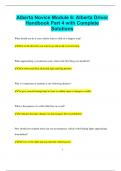
-
Alberta Novice Module 6: Alberta Driver Handbook Part 4 with Complete Solutions
- Exam (elaborations) • 5 pages • 2024
-
Available in package deal
-
- $8.99
- + learn more
Alberta Novice Module 6: Alberta Driver Handbook Part 4 with Complete Solutions What should you do if your vehicle starts to skid on a slippery road? Steer in the direction you want to go and avoid overcorrecting. When approaching a construction zone, what is the first thing you should do? Slow down and obey all posted signs and flag persons. Why is it important to maintain a safe following distance? To give yourself enough time to react to sudden stops or changes in traffic. ...
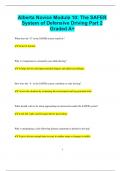
-
Alberta Novice Module 10: The SAFER System of Defensive Driving Part 2 Graded A+
- Exam (elaborations) • 7 pages • 2024
-
Available in package deal
-
- $9.99
- + learn more
Alberta Novice Module 10: The SAFER System of Defensive Driving Part 2 Graded A+ What does the "S" in the SAFER system stand for? Scan for hazards Why is it important to constantly scan while driving? It helps drivers anticipate potential dangers and adjust accordingly. How does the "A" in the SAFER system contribute to safer driving? Assess the situation by evaluating the environment and any potential risks. What should a driver do when approaching an intersect...
Alberta Novice Module 10 and 16 The SAFER System of Defensive Driving Part 2
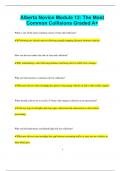
-
Alberta Novice Module 13: The Most Common Collisions Graded A+
- Exam (elaborations) • 7 pages • 2024
-
Available in package deal
-
- $9.99
- + learn more
Alberta Novice Module 13: The Most Common Collisions Graded A+ What is one of the most common causes of rear-end collisions? Following too closely and not allowing enough stopping distance between vehicles. How can drivers reduce the risk of rear-end collisions? By maintaining a safe following distance and being alert to traffic flow changes. Why are intersections a common site for collisions? Because drivers often misjudge the speed of oncoming vehicles or fail to obey traffic signals. ...
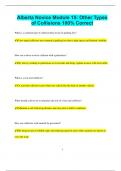
-
Alberta Novice Module 15: Other Types of Collisions 100% Correct
- Exam (elaborations) • 6 pages • 2024
-
Available in package deal
-
- $9.99
- + learn more
Alberta Novice Module 15: Other Types of Collisions 100% Correct What is a common type of collision that occurs in parking lots? Low-speed collisions are common in parking lots due to tight spaces and limited visibility. How can a driver avoid a collision with a pedestrian? By always yielding to pedestrians at crosswalks and being vigilant in areas with foot traffic. What is a rear-end collision? A rear-end collision occurs when one vehicle hits the back of another vehicle. W...

-
Alberta Novice Module 5: Alberta Driver Handbook Part 3 Questions and Answers Graded A+
- Exam (elaborations) • 4 pages • 2024
-
Available in package deal
-
- $8.49
- + learn more
Alberta Novice Module 5: Alberta Driver Handbook Part 3 Questions and Answers Graded A+ Why is it important to wear a seatbelt while driving? Seatbelts significantly reduce the risk of serious injury or death in the event of a collision. What should a driver do if they encounter a school bus with its lights flashing? Drivers must stop at least 5 meters away from the bus and cannot proceed until the lights stop flashing and it is safe to do so. Why is it crucial to signal before c...
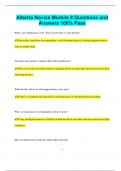
-
Alberta Novice Module 8 Questions and Answers 100% Pass
- Exam (elaborations) • 8 pages • 2024
-
Available in package deal
-
- $9.99
- + learn more
Alberta Novice Module 8 Questions and Answers 100% Pass What is the significance of the "three-second rule" in safe driving? It provides a guideline for maintaining a safe following distance, allowing adequate time to react to sudden stops. How does road surface condition affect driving behavior? Wet or icy roads can reduce traction, requiring drivers to adjust their speed and increase their following distance. What should a driver do when approaching a stop sign? Come to ...
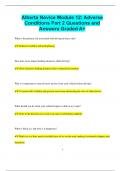
-
Alberta Novice Module 12: Adverse Conditions Part 2 Questions and Answers Graded A+
- Exam (elaborations) • 6 pages • 2024
-
Available in package deal
-
- $9.99
- + learn more
Alberta Novice Module 12: Adverse Conditions Part 2 Questions and Answers Graded A+ What is the primary risk associated with driving in heavy rain? Reduced visibility and hydroplaning How does snow impact braking distances while driving? Snow increases braking distances due to reduced tire traction Why is it important to clear all snow and ice from your vehicle before driving? To ensure full visibility and prevent snow from obstructing the view of other drivers What should ...
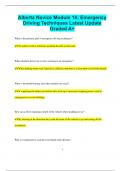
-
Alberta Novice Module 16: Emergency Driving Techniques Latest Update Graded A+
- Exam (elaborations) • 6 pages • 2024
-
Available in package deal
-
- $9.99
- + learn more
Alberta Novice Module 16: Emergency Driving Techniques Latest Update Graded A+ What is the primary goal of emergency driving techniques? To safely avoid or minimize potential hazards on the road. When should a driver use evasive steering in an emergency? When braking alone won’t prevent a collision, and there’s a clear path to avoid the hazard. What is threshold braking, and when should it be used? It’s applying the brakes just before they lock up to maximize stopping power...
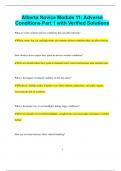
-
Alberta Novice Module 11: Adverse Conditions Part 1 with Verified Solutions
- Exam (elaborations) • 5 pages • 2024
-
Available in package deal
-
- $8.99
- + learn more
Alberta Novice Module 11: Adverse Conditions Part 1 with Verified Solutions What are some common adverse conditions that can affect driving? Rain, snow, fog, ice, and high winds are common adverse conditions that can affect driving. How should a driver adjust their speed in adverse weather conditions? Drivers should reduce their speed to maintain better control and increase their reaction time. What is the impact of reduced visibility on driving safety? Reduced visibility makes it h...

That summary you just bought made someone very happy. Also get paid weekly? Sell your study resources on Stuvia! Discover all about earning on Stuvia

